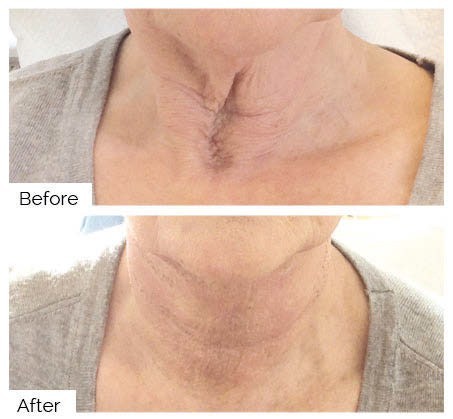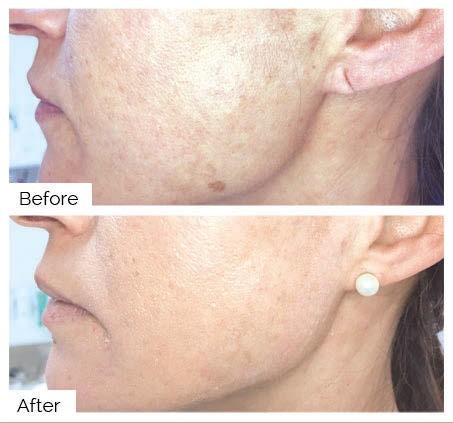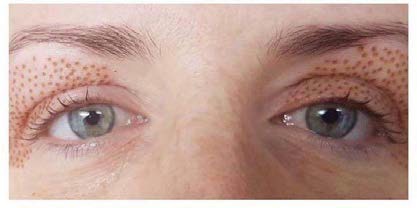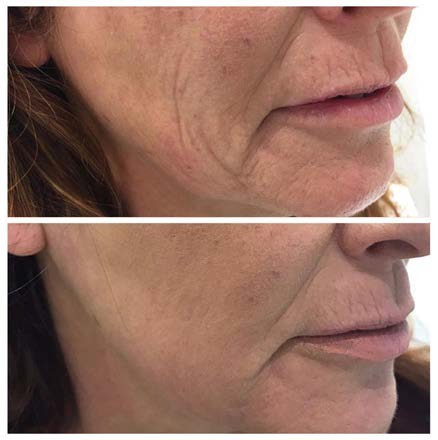Burst OF ENERGY
Plasma is the latest industry buzzword, but how does it work, and what can it do? GEORGIA SEAGO gives you the lowdown
GEORGIA SEAGO
Plasma Technology
A new skin rejuvenation technology has emerged onto the beauty scene over the past year. Plasma claims a non-invasive route to results that rival cosmetic surgery and last just as long. Originally developed for medical applications, plasma emerged as an aesthetic treatment around two years ago. More recently, its adoption by salon brands such as Caci and Crystal Clear has seen the technology transition into more mainstream use. However, not all plasma is the same. Devices vary largely in energy output and results, and with so many now on the market it’s important to understand the differences in capabilities and risks of each.
Plasma is often referred to as “the fourth state of matter”, after solid, liquid and gas. It is created when electrostatic energy mixes with an ionised gas. When the thermal energy from a plasma device reaches around 1mm from the skin, it mixes with oxygen and nitrogen in the atmosphere and creates a plasma arc, which vaporises upon contact with the skin.
“In doing so, we force immediate contraction of the skin tissue at the surface and cause thermal disruption within the dermis below, especially to the fibroblasts,” explains Louise Walsh, chief executive of Plasma Pen by Louise Walsh International. “The precision trauma we cause to the epidermis makes the skin dry superficially into tiny carbon crusts, which fall off within a few days, leaving new, rejuvenated skin at the surface.”
Plasma Pen is an example of a device that sits towards the top end of the aesthetic remit – non-invasive but with a high enough energy output to create trauma to the epidermis and cause carbon crusting. At the lower end of the impact scale in terms of output, pain and downtime are handpieces such as Caci’s Skinbreeze Neon Plasma, which has a neon gas-filled electrode at its tip. This generates a plasma field by passing a mild, high-frequency current through the electrode.
“Heat is transferred sub-dermally when the plasma field makes contact with the skin, causing the elastin and collagen fibres to shrink, producing an immediate skintightening effect,” says Caci trainer Nina Hardy. “As neon gas generates less heat than ionised nitrogen or oxygen, there is no risk of scabbing,” she adds.
Indications for plasma
Plasma is generating a lot of attention because it offers a non-surgical alternative to blepharoplasty (or eyelid surgery). “There’s really no equivalent treatment out there for the eyes outside of plastic surgery. We can work all around the periorbital region,” says Walsh.
Clients are also most commonly requesting blepharoplasty treatment with Crystal Clear’s Plasma Lift machine – which is a pulsed nitrogen plasma device that treats at a lower energy output with a larger probe than aesthetic-grade devices – says training manager Sadie Smith, as well as for skin tightening on the backs of the hands.
Other indications include frown lines, crow’s feet, nasolabial folds, jawline augmentation and loose skin on the arms, stomach, neck and décolleté.
“Most indications will only require one treatment, but it is affected by the depth of the indication,” says Josh Yardley, director of The Smart Group, which distributes the Accor Cosmetic Corrector plasma pen in the UK, adding: “80% of all Accor treatments are individual treatments.” The Accor pen has built-in NF+ technology, which means “the intensity of the thermal energy diminishes the further down into the skin it goes”, explains Yardley. This low-frequency delivery is intended to keep the treatment area superficial but allow the device to work safely on a larger area, reducing swelling and redness.
Some types of plasma tech can also be used for all-over facial rejuvenation. As a new handpiece for the existing Skinbreeze device, Caci’s 20-minute Neon Plasma salon treatment “can be incorporated into any salon facial to treat ageing concerns such as fine lines, wrinkles and sun damage”, says Hardy. “The treatment is pain-free and there are no contraindications.”
PLASMA JARGON EXPLAINED
• AC: Almost all aesthetic-grade plasma devices on the market use an alternating current (AC) that creates a tiny spark. An AC device can only be used on skins up to a Fitzpatrick 3 or 4 because of the risk of causing post-inflammatory hyperpigmentation (PIH) on darker skins.
• DC: Direct current (DC) devices such as Jett Medical’s Plasma Lift Profi can treat the full Fitzpatrick scale because it creates a longer arc and doesn’t damage surrounding tissue, meaning it’s less likely to cause residual PIH.
• Sublimation: This is the process by which plasma technology works, by instantly vaporising a solid into a gas.
• Sublative: Ablative procedures are invasive and break the skin’s basal layer. Generally, only medical professionals can use ablative devices. Most aesthetic-grade plasma devices are sublative, referring to the tiny holes created in the epidermis.
• Nitrogen plasma: These devices feature a gas tank and convert medical-grade nitrogen gas into plasma energy. Nitrogen plasma delivers controlled heating of skin tissue without epidermal vaporisation. Instead, they work on modifying the skin’s structure and improving tone, texture and laxity. The gas requires replenishing on an ongoing basis.
• Neon plasma: This type of plasma uses electrically charged inert neon gas to create a plasma field, which heats the skin sub-dermally. It generates less heat than nitrogen or oxygen and, like nitrogen plasma, doesn’t cause vaporisation. These devices usually require a course of treatment and can be used over the whole face in one session.
Caci Skinbreeze Neon Plasma
Caci’s Skinbreeze facial rejuvenation system has been updated to include a Neon Plasma hand piece for skin tightening. It passes a mild high-frequency current through a gas-filled glass electrode, which then becomes ionised and is converted into a plasma field upon contact with the skin. The technology can be used for overall improvement of skin texture and tone, with a course of 10 to 15 treatments recommended.
Pay as you use from £8 per day 020 8731 5678 caci-international.co.uk
Managing contraindications
There are, however, contraindications for aesthetic-grade devices, and because the technology is relatively new to this arena, it’s likely that more will emerge as the devices become more widely used. “We have a very broad and constantly updated list of contraindications that our technicians work to rigidly,” says Walsh. The first is that Plasma Pen can’t be used on skins darker than a Fitzpatrick 3 because of the risk of post-inflammatory hyperpigmentation. Meanwhile, Accor lists the following contraindications to plasma treatment with its Cosmetic Corrector:
• Pregnancy
• Nursing mothers
• Metal implants
• Pacemakers
• Fever or current infections
• Anti-acne medication
• Skin lesions in the area being treated
• Cancers
• All forms of hepatitis
• Varicose veins in the area being treated
• Bone disease
• Epilepsy
• Autoimmune disease
• Diabetes
• Keloid predisposition
• Filler, thread-lift or botulinum toxin in the area being treated.
As with any tech, each device will have slightly different contraindications, so always check with manufacturers before investing.
Considerations and risks
There are a few other important considerations to be aware of before adding plasma treatments to your menu. Most devices require downtime posttreatment of at least a week. “We encourage clients to let the skin go through its natural healing process for seven days and just use sun protection,” says Smith, while Tracie Giles, founder of Tracie Giles Bespoke Permanent Make Up, instructs her plasma clients to send her a picture of their eyes every morning for 10 days after blepharoplasty to check how they’re healing. “However prepared a client is, if they’re having plasma around the eyes, they’re going to get massive lymphedema and that can be quite scary,” she says.
Accor NF+ Cosmetic Corrector
Designed with ease of use in mind, this pen weighs 95g so practitioners can maintain a healthy posture during treatment. Fully charged, it gives up to eight hours’ battery life and can also be used without a power source or in a stationary set up with cable usage. It’s made from fibreglass-strengthened plastic and an aluminium compound.
Topical anaesthetic is needed and one to two treatments are usually sufficient for most indications.
£5,950 for a Starter Kit 01344 411480 (The Smart Group) smarths.org

Accor – before and after one treatment for throat lift

Accor – before and after one treatment for pigment reduction
Giles also patch tests every client – whether she plans on carrying out the treatment using her own TG Plasma Linear pen, which is an alternating current (AC) device, or the Jett Plasma from Jett Medical, which uses direct current (DC) and for which she was the aesthetic lead during launch into the market. “I patch test so clients can experience how it feels and how their skin is going to heal,” she explains. “It’s also about checking for compliance with the aftercare advice I give them for the skin we tested.” It is important clients are aware that aesthetic-grade plasma treatments are painful and require topical anaesthetic: “It’s a really painful treatment and there’s no getting away from that,” says Giles.
However, devices like the Crystal Clear Plasma Lift, which uses nitrogen from a built-in tank in the machine, have a much lower energy output than their aesthetic counterparts and are generally less painful. Smith says with Plasma Lift the discomfort is “more post-treatment when the client feels the heat start to build up in the skin; it feels like extreme sunburn. It’s not going to be for everyone,” she says.
It’s also imperative to make sure the device you’re thinking of investing in has a CE registration and certificate of compliance that indicates product liability insurance, says Yardley, in light of the influx of cheap, nontraceable plasma devices entering the market from overseas. He advises to “check the output of the device and its effects on the epidermis” beforehand, adding, “In the wrong hands, it can cause scarring and bleeding.”
It’s even possible that some of these imported pens or machines aren’t actually plasma devices. “Some actually burn the skin upon touching it, which means they’re not plasma at all but cauterising devices,” says Giles, and of those that are plasma, “a lot of them are uncalibrated, so there’s not a safety standard for it to adhere to.”
Training needed
All the brands we spoke to for this feature stipulate a minimum Level 3 qualification for therapists to train in and take on their plasma device. “A lot of insurance companies are starting to stipulate that too, and we work closely with trainees to make sure they can get insured before training,” says Smith. “But it is often on a case-by-case basis. For example, if someone had been a therapist for 20 years but never did an NVQ Level 3, they may be more likely to get insurance than a therapist just out of college with no salon or clinical experience but a qualification,” she says.
Crystal Clear Plasma Lift
This machine uses nitrogen plasma to generate new skin, working below the epidermis to modify the skin’s architecture. It can be used to treat active acne and rosacea as well as the usual skin-tightening indications for plasma.
The device has three recommended treatment protocols that deliver thermal energy ranging from 0.5 to 0.8 Joules.
£24,995
0151 709 7227 crystalclear.co.uk
Jett Medical Jett Plasma Lift Profi
Beauty therapists can use this lower-intensity version of Jett’s medical-only device, which it claims is the only DC plasma technology on the market. The Profi has five intensity settings and a 0.1mm dot size delivered to a controlled depth. It can also be used to “scan” the skin, offering a more even treatment of larger areas. It comes with five applicator heads: cone, flat, 5mm, 3mm and golden.
£7,500
07933 096733 jett-medical.co.uk
Plasma Elite
Training with the Plasma Elite machine teaches patterns and placement sequences to create bespoke reduction grids, enabling practitioners to give results suited to every client’s facial structure and characteristics. The Starter Kit includes the machine and case, aftercare balm, probes for 10 treatments and 50 consumer leaflets, as well as training and aftercare support.
£3,999 for the Starter Kit 07967 392081 plasmaelite.com

Plasma Elite – before and after blepharoplasty
Walsh echoes this: “Insurers each have their own requirements and Level 3 is not always essential, depending on other training, techniques and each practitioner’s background.” Accor will only supply “clinically experienced” therapists of Level 3 and above, with a firm understanding of anatomy and physiology, who have worked in salons or clinics for a minimum of three years.
“We have a duty of care to the consumer so as a manufacturer or supplier we must pass that on to our practitioners,” says Yardley of Accor’s training programme. Practical training is done by one trainer to two students and they’re mentored by a trainer with a minimum of five years’ experience as well as a master trainer. Practitioners also have the support of fellow Accor users through a Facebook network.
Since plasma has started to generate interest in the beauty world, Giles tells of clients contacting her for help after experiencing bad treatments, prompting concerns that the technology should be reserved for Level 5 and above. “They’re left with little indentations in the skin because the spot was held on for just a fraction too long. My feeling is that it’s a Level 5 treatment and nobody below that should be offering it,” she says.
Giles is particularly concerned about the targeting of plasma devices towards semipermanent make-up (SPMU) artists on social media platforms: “My concern is that some SMPUs aren’t even Level 3 trained, and while the pens are very similar to SPMU pens, the application of the technology is entirely different. It’s quite a scientific treatment and there’s a lot of physics, physiology and anatomy involved.
“Plasma is an alternative to surgery and we mustn’t lose sight of that. It’s an unbelievable treatment – the results are life changing for some people – but it has to be delivered in competent hands,” she says.

Plasma Pen – before and 12 weeks after one treatment
Plasma Pen
German-manufactured Plasma Pen comes with adaptable screw-in probes and has fingertip control for precision treatments. Special techniques known as centre point, falten spotting, spray shade and combi blast are taught during training, and there are several pre-procedure and aftercare products available, including Colloidal Silver Gel and Frozen Eye Masks with aloe vera.
£3,250 01704 579800 plasmapenuk.com